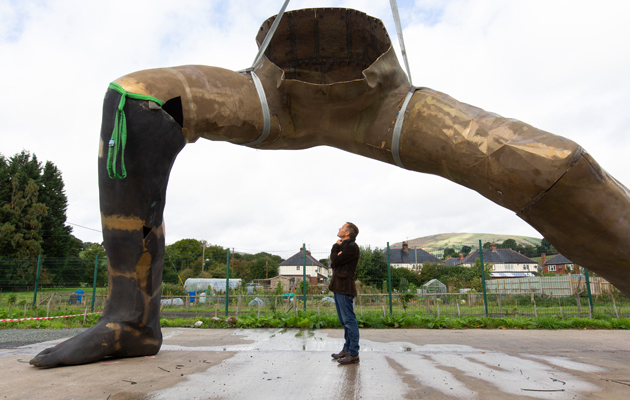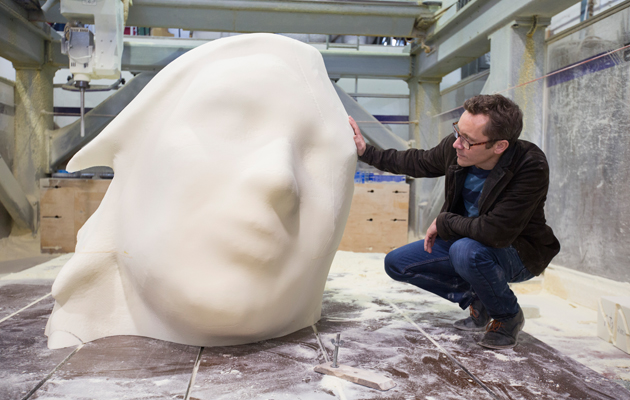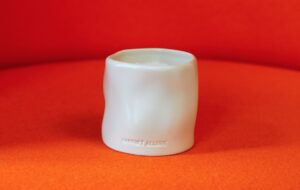 Joseph Hillier with the sculpture. Photo by Andrew Fox
Joseph Hillier with the sculpture. Photo by Andrew Fox
The UK’s largest bronze sculpture is set to be unveiled in Plymouth on 25 March – and, notably in a town dominated by statues of military men, this sculpture is a woman.
According to research by the Public Monuments and Sculpture Association, reported by the BBC, only one fifth of statues in the UK are of women. Of these, just under half have a name or title and around 40% are of fictional people or beings. The lack of female statues in the UK gained prominence in 2018, when a campaign by journalist and author Caroline Criado Perez resulted in Parliament Square in London gaining its first statue of a woman – Dame Millicent Garratt Fawcett, women’s suffrage campaigner.
In Plymouth, the sculpture, titled Messenger, will be seven metres tall and nine metres wide, and weigh 9.5 tonnes with a volume of 25.6 cubic metres. It will stand outside the Theatre Royal Plymouth and is part of the city’s £7.5 million regeneration plans. The theatre’s chief executive, Adrian Vinken OBE, expressed his hope that it can have an impact similar to the Angel of the North in Gateshead, now a symbol of that region.
Sculptor Joseph Hillier created the piece based on an actor in a rehearsal for Othello, produced by Frantic Assembly for Plymouth’s Theatre Royal in 2014. He decided on the pose, a woman crouching, ready to explode into movement, to create a sense of vitality and dynamism, and told Icon that he did not want to work with a traditional model-sculptor dynamic, ‘as I feel the exchange of power and the gaze in that scenario can be a bit one way. ‘
Hillier’s process combined traditional and modern techniques, using lost-wax cast method to create the sculpture but incorporating technology in its original design. To capture the actor’s pose, Hillier used 3D scanning and computer aided design (CAD), turning the pose into a sculpture made up of 200 panels. These were carved into polyurethane foam, turned into a silicon mould and hand painted with wax in order to create the ceramic mould that allowed for the final sculpture to be created. The Castle Fine Arts foundry in Wales poured in the molten bronze into each panel, finally welding together the 200 panels into the sculpture, which is being placed into place piece by piece.
Icon asked Joseph Hillier about the sculpting process, his choice of subject and the significance of creating a female figure for the largest bronze statue in the UK.
 Messenger foam head Bakers Pattern Cutters. Photo by Andrew Fox
Messenger foam head Bakers Pattern Cutters. Photo by Andrew Fox
Icon: Why was it important to you to create a sculpture of a woman? More generally, what role do you think sculpture has in the discussion about representation?
Joseph Hillier: I have been aware for some time of the underrepresentation of women in both public sculpture and my work. I was also very reticent to work with models as I feel the exchange of power and the gaze in that scenario can be a bit one way. I was particularly interested in working with actors because, like me, they use the human body to communicate, as a sort of tool. I therefore made a series of pieces with the actors in a production by Frantic Assembly and was interested in exploring their creative process in rehearsal. The piece I have chosen to make on this huge scale, Messenger, happened to be based on a member of the cast who was in a supporting role but had a really interesting presence that I felt was tentative and slight. It was the tension of a moment when she was poised and in a quite contained crouching pose that caught something intriguing.
Icon: Why did you decide to choose an anonymous character in particular, and how did you decide on the subject?
JH: The subject was not chosen for reasons of commemoration or portraiture, but more for her action and the creative process she was in, namely a rehearsal for a new theatrical production of Othello. It was the pertinence of this to the theatre and how I felt this poised moment could signify much more for the city and the transformational effect artists can bring, that moment felt like a catalyst, a spark.
Icon: How did you find the process of using 3D scanning and CAD alongside the traditional techniques of sculpture?
JH: I feel these are just really exciting new tools at my disposal. Some people refer to 3D scanning as physical photography, which I like. I think it reminds us that photography has been absorbed and used relative to painting for a long time. When painters imitate cameras, we now think this is real, like when Richter painted the back of his daughter’s head and the background is out of focus; this has become shorthand for accuracy.
I think when we are living through a digital revolution it is pertinent to address that tension between the handmade and the machine made. I find technology in some senses liberating because it frees representation from the rhetoric of style and touch, but conversely to actually replicate the cool hard facets of the digital into bronze has taken a lot of attention to detail and craft. Every inch of that surface has been worked over, sanded cast into wax then bronze, it is a real labour of love by over 25 dedicated makers.
I feel my hand and the life of the work took place in a pre-material way, in the digital three-dimensional drawing that decided the exact form of the piece. As a very hands-on maker of my own work (I generally make all my own pieces entirely in my studio up to about 3 meters, and I cast a lot of my own bronzes), I found the decision to hand production of the full scale work over to others difficult but essential.
Sculpture on this scale has always been a collaborative effort and I am extremely grateful to the 30 men and women who have worked on this piece from castle fine arts in wales for the last year.
Icon: Are there any artists or sculptors (particularly women) who particularly inspire you, either now or from the past?
JH: I am fortunate to have been taught by some great female artists the incredible Phyllida Barlow, Janaine Antoni and (the recently and sadly lost) Susan Hiller, who told me about the MFA course I went on to study at Tulane in New Orleans. Other great female artists I admire include Louise Bourgeois, Eva Hesse, Doris Salcedo, Dora Gordine, Rebecca Warren… The list goes on.
Joseph Hillier’s Messenger will be installed outside Theatre Royal Plymouth on 25 March 2019

















